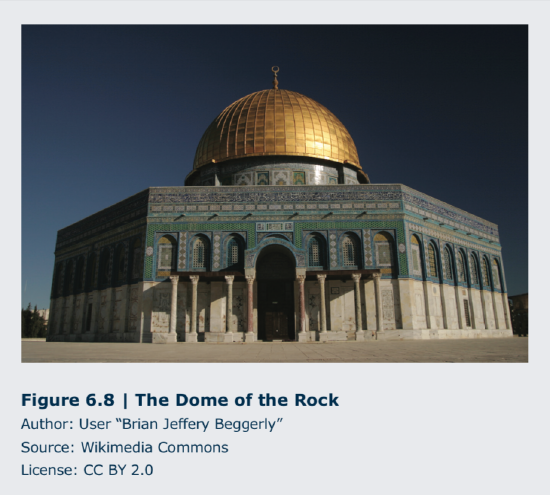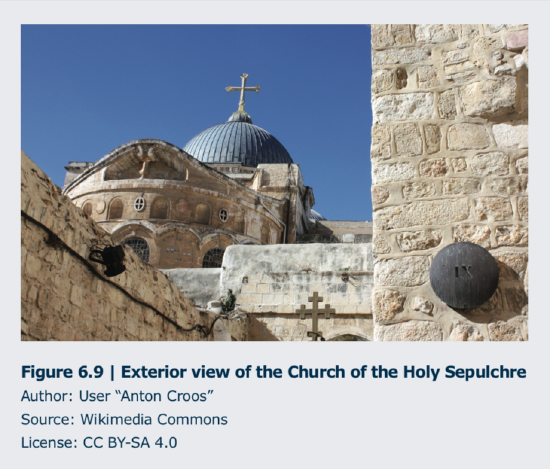6.5: UNIFICATION/EXCLUSION
- Page ID
- 10146
Art and architecture can be used as a means of bringing together a group of people with like beliefs or views, and emphasizing what they have in common. In demonstrating how they are alike, such objects and places can also indicate how others are different, which can lead to the exclusion of those who hold different beliefs or views. The Dome of the Rock is such a place.

The events that have been agreed upon as having occurred, and their relative importance, are key
to understanding the Dome of the Rock or Qubbatas Kakhrah in Jerusalem. (Figure 6.8) Its site, origins, and various past and present uses are all factors in the shrine’s meaning and significance to the people of different backgrounds and faiths for whom it is a holy place. The Dome of the Rock was completed in 691 CE as a shrine for Muslim pilgrims by the Umayyad caliph, or political and religious leader, Abd al-Malik. The sacred rock upon which the shrine is built marks the site where Muhammad ascended to heaven on a winged horse. Part of the Temple Mount or Mount Zion, the rock is said to have great importance before Muhammad, as well, by those of the Jewish, Roman, and Christian faiths. It is the site where Abraham prepared to sacrifice his son, Isaac; according to the Hebrew Bible, Solomon’s Temple, also known as the First Temple, was later erected there; Herod’s Temple, completed during the reign of the Persian King Darius I around 516 BCE was next built; and it was destroyed in 70 CE under Roman Emperor Titus, who had a temple to the god Jupiter built on the site.
As Christianity grew in the succeeding centuries, the city of Jerusalem, then part of the Byzantine Empire (c. 330-1453), became a destination for pilgrims visiting places Jesus was said to have lived or traveled to in his lifetime. But, the city came under Muslim rule in 637 CE, and it is thought that Caliph Abd al-Malik had the Dome of the Rock built on the holy site to demonstrate the lasting power of the Islamic faith, and to rival the Byzantine Christian churches in the region. As a young faith, Islam did not yet have a “vocabulary” of architectural forms established. Muslim builders and artisans instead borrowed from existing structures houses of worship, palaces, fortifications throughout the Mediterranean and Near East.

One of the inspirations for the Dome of the Rock is the dome of the Church of the Holy Sepulcher, also in Jerusalem, that was built in 325/326 CE on what is believed to be Calvary, where Jesus was crucified, as well as the sepulcher, or tomb, where he was buried and resurrected. (Figure 6.9) While the overall plans of the two buildings are
markedly different, the domes are nearly the same shape and size: the dome of the Church of the Holy Sepulcher is approximately sixty-nine feet in height and diameter, while that of the Dome of the Rock is sixty-seven feet. Each of the eight outer walls of the Dome of the Rock is sixty-seven feet, as well, giving the octagonal structure the balance of relative proportions, and rhythmic repetition of forms found in many Christian central-plan churches, that is, with the primary space located in the center. (Interior Diagram of the Church: https://classconnection.s3.amazonaws...4161178159.jpg) The Dome of the Rock has passed between the hands of Muslims, Christians, and Jews many times since it was built. Today, Jerusalem is part of Israel, but the Dome of the Rock is maintained by an Islamic council within Jordan’s Ministry of Awqaf (religious trust), Islamic Affairs, and Holy Places. Since 2006, non-Muslims have again been allowed on the Temple Mount, during certain hours and after having gone through security checkpoints, but Muslims only are allowed into the Dome of the Rock. Some Orthodox Jews believe it is against their faith to visit the holy site at all.
The Dome of the Rock is one example of a holy site upon which a building or a succession of buildings devoted to different religious beliefs has been erected. Such a structure may have been used for hundreds of years by a group following a faith dissimilar to those before or after who claim ownership of it, and the structure may share architectural elements with houses of worship from other religious systems. Those things are not necessarily important to the believers, although there are numerous occasions in history when destruction of a holy building with the intention of replacing it with a place of worship sacred to the new regime symbolizes a conqueror’s defeat of a people and their religion.
Key, however, is the conviction that the site is hallowed: the holiness of the place is believed without question. Keeping that in mind, recognizing the long, varied, and sometimes contentious history of the Temple Mount, the Dome of the Rock, and the city of Jerusalem, as well as the significance of events that have taken place there to people of the Jewish, Islamic, and Christian faiths, what is remarkable is the site is not one of exclusion. There is tension and at best a parallel existence of religious ideologies, but considering the divergent meanings and strong significance of the site as a place of pilgrimage and worship to so many, while the Dome of the Rock is far from being a model of unification, it is not an example of rejection.
 On a more individual level, Winslow Homer (1836-1910, USA) was born in Boston, Massachusetts, and started his career there as a printmaker before moving to New York City in 1859. He opened his own studio and did freelance work for Harper’s Weekly, making sketches that he and other illustrators produced as wood engravings for the journal. Once the Civil War began in 1861, Homer became an artist-correspondent for the magazine, sometimes traveling to capture scenes on battlegrounds, in soldiers’ camps, and other newsworthy locales. He often created informal narratives about both military and civilian life, the war as experienced by those on the battle lines as well as the home front. His images and the stories they told were about the people, their efforts, bravery, sacrifices, and attempts to maintain a semblance of normalcy in the midst of a war that was tearing the nation apart.
On a more individual level, Winslow Homer (1836-1910, USA) was born in Boston, Massachusetts, and started his career there as a printmaker before moving to New York City in 1859. He opened his own studio and did freelance work for Harper’s Weekly, making sketches that he and other illustrators produced as wood engravings for the journal. Once the Civil War began in 1861, Homer became an artist-correspondent for the magazine, sometimes traveling to capture scenes on battlegrounds, in soldiers’ camps, and other newsworthy locales. He often created informal narratives about both military and civilian life, the war as experienced by those on the battle lines as well as the home front. His images and the stories they told were about the people, their efforts, bravery, sacrifices, and attempts to maintain a semblance of normalcy in the midst of a war that was tearing the nation apart.
In addition to his drawings and prints, Homer began painting Civil War subjects in 1862. He showed a number of these paintings to critical and popular acclaim in the annual exhibitions at the National Academy of Design in New York between 1863 and 1866. One of the last Civil War paintings he created was The Veteran in a New Field. (Figure 6.10) He started it shortly after the war ended and President Abraham Lincoln was assassinated, both events occurring in April 1865. Homer depicts a soldier who has returned to his farm. Having cast aside his Union jacket, the soldier farmer has taken up his scythe and, with broad horizontal sweeps, harvests a bountiful crop. This quiet scene is a reminder of the never-ending process of life, death, and rebirth. Homer captures the sense of anxious relief, deep sorrow, and tentative hope individuals and nation alike were experiencing at that time of transition.
Homer was quietly calling for a healing of the Union, seeking grounds for unification of a bitterly divided and sorely wounded nation. He saw this recovery as being possible through the continuity of meaning found in the land and commonalities of work.


